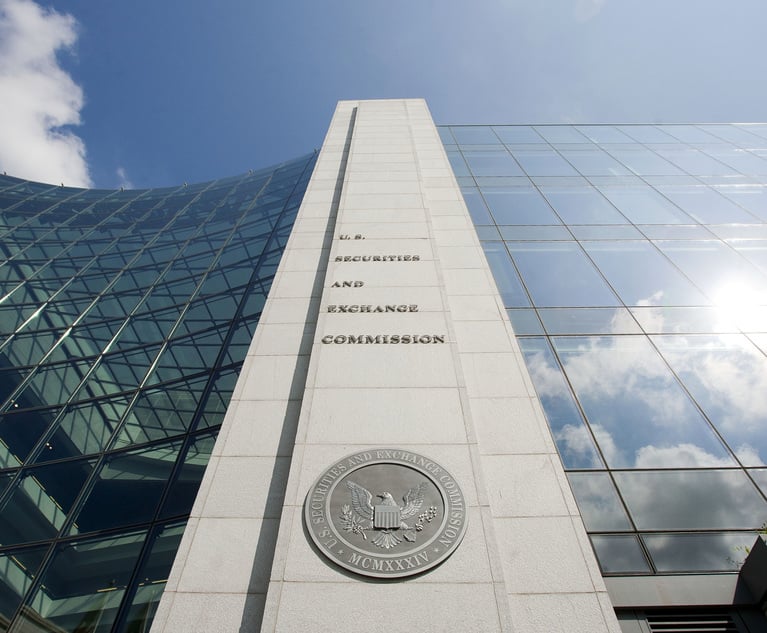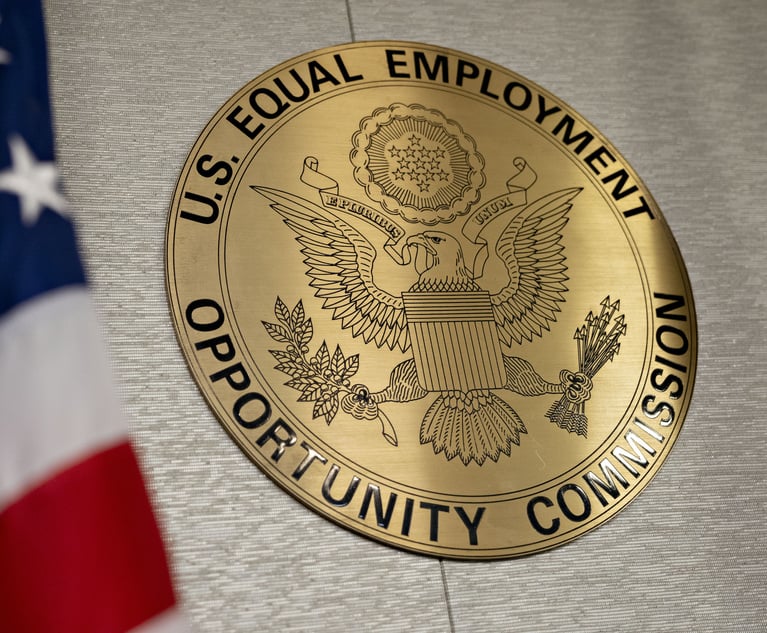DOJ investigation reveals JPMorgan ignored red flags as early as 2006
The DOJs investigation, which led to its $13 billion dollar settlement with JPMorgan, was more than a year in the making.
November 21, 2013 at 06:19 AM
6 minute read
The original version of this story was published on Law.com
How did JPMorgan Chase get from a well-respected, profit-making bank to the entity that now needs to pay $13 billion for its role in issuing faulty mortgage-backed securities? The Department of Justice (DOJ) says that it all began as far back as two years before the financial crisis.
The DOJ revealed the results of its yearlong investigation into the financial services firm's past doings on Nov. 19, which laid the groundwork for the landmark settlement between the two parties. According to DOJ officials, the investigation uncovered that JPMorgan knowingly ignored red flags. According to the investigation, executives were made aware of the indiscretions at meetings as early as 2006 but continued selling the shoddy mortgage-backed securities anyway.
“Without a doubt, the conduct uncovered in this investigation helped sow the seeds of the mortgage meltdown,” U.S. Attorney General Eric Holder said in a statement. “J.P. Morgan was not the only financial institution during this period to knowingly bundle toxic loans and sell them to unsuspecting investors, but that is no excuse for the firm's behavior.”
The DOJ says that JPMorgan fully cooperated with the investigation, especially as it was eager to get out from under its legal mess. In recent days, JPMorgan also cut a check to investors worth $4.5 billion, separate from the DOJ settlement, for damages lost in the 2008 financial crisis.
According to JPMorgan CEO Jaime Dimon, the company is simply ready to move on. He said in a statement that the bank is “pleased to have concluded this extensive agreement” and that the agreement “covers a very significant portion” of the faulty securities provided by JPMorgan and other companies now under the bank's wing, such as Bear Stearns and Washington Mutual. He also said in a conference call that he “simply wouldn't undertake” a deal like the Bear Stearns purchase again.
However, it does not seem that the DOJ's work is quite yet done. Holder said in his announcement that the DOJ's probe of government banks “is far from over.” Deputy U.S. Attorney General John Cole also recently said that he finds banks' compliance lacking and that “we cannot help but feel that the message [of compliance] is not getting through often enough or clearly enough.”
For more on JPMorgan's ongoing legal troubles, check out these InsideCounsel stories:
JPMorgan Chase finalizes deal with DOJ
JPMorgan cuts deal with investors over mortgage-backed securities
U.S. attorney opening criminal probe into J.P. Morgan's dealings
JPMorgan settles with Commodity Future Trading Commission in new “London Whale” deal
Legal costs blast J.P. Morgan's bottom line
How did
The DOJ revealed the results of its yearlong investigation into the financial services firm's past doings on Nov. 19, which laid the groundwork for the landmark settlement between the two parties. According to DOJ officials, the investigation uncovered that JPMorgan knowingly ignored red flags. According to the investigation, executives were made aware of the indiscretions at meetings as early as 2006 but continued selling the shoddy mortgage-backed securities anyway.
“Without a doubt, the conduct uncovered in this investigation helped sow the seeds of the mortgage meltdown,” U.S. Attorney General Eric Holder said in a statement. “J.P. Morgan was not the only financial institution during this period to knowingly bundle toxic loans and sell them to unsuspecting investors, but that is no excuse for the firm's behavior.”
The DOJ says that JPMorgan fully cooperated with the investigation, especially as it was eager to get out from under its legal mess. In recent days, JPMorgan also cut a check to investors worth $4.5 billion, separate from the DOJ settlement, for damages lost in the 2008 financial crisis.
According to JPMorgan CEO Jaime Dimon, the company is simply ready to move on. He said in a statement that the bank is “pleased to have concluded this extensive agreement” and that the agreement “covers a very significant portion” of the faulty securities provided by JPMorgan and other companies now under the bank's wing, such as Bear Stearns and Washington Mutual. He also said in a conference call that he “simply wouldn't undertake” a deal like the Bear Stearns purchase again.
However, it does not seem that the DOJ's work is quite yet done. Holder said in his announcement that the DOJ's probe of government banks “is far from over.” Deputy U.S. Attorney General John Cole also recently said that he finds banks' compliance lacking and that “we cannot help but feel that the message [of compliance] is not getting through often enough or clearly enough.”
For more on JPMorgan's ongoing legal troubles, check out these InsideCounsel stories:
JPMorgan cuts deal with investors over mortgage-backed securities
U.S. attorney opening criminal probe into J.P. Morgan's dealings
JPMorgan settles with Commodity Future Trading Commission in new “London Whale” deal
This content has been archived. It is available through our partners, LexisNexis® and Bloomberg Law.
To view this content, please continue to their sites.
Not a Lexis Subscriber?
Subscribe Now
Not a Bloomberg Law Subscriber?
Subscribe Now
NOT FOR REPRINT
© 2025 ALM Global, LLC, All Rights Reserved. Request academic re-use from www.copyright.com. All other uses, submit a request to [email protected]. For more information visit Asset & Logo Licensing.
You Might Like
View All

Trending Stories
- 1Data Breaches in UK Legal Sector Surge, According to ICO Data
- 2PayPal Faces New Round of Claims; This Time Alleging Its 'Honey' Browser Extension Cheated Consumers
- 3Fired NLRB Member Seeks Reinstatement, Challenges President's Removal Power
- 4NY Inspector General Announces Attorneys Hired to Lead Upstate Region and Gaming
- 5Carol-Lisa Phillips to Rise to Broward Chief Judge as Jack Tuter Weighs Next Move
Who Got The Work
J. Brugh Lower of Gibbons has entered an appearance for industrial equipment supplier Devco Corporation in a pending trademark infringement lawsuit. The suit, accusing the defendant of selling knock-off Graco products, was filed Dec. 18 in New Jersey District Court by Rivkin Radler on behalf of Graco Inc. and Graco Minnesota. The case, assigned to U.S. District Judge Zahid N. Quraishi, is 3:24-cv-11294, Graco Inc. et al v. Devco Corporation.
Who Got The Work
Rebecca Maller-Stein and Kent A. Yalowitz of Arnold & Porter Kaye Scholer have entered their appearances for Hanaco Venture Capital and its executives, Lior Prosor and David Frankel, in a pending securities lawsuit. The action, filed on Dec. 24 in New York Southern District Court by Zell, Aron & Co. on behalf of Goldeneye Advisors, accuses the defendants of negligently and fraudulently managing the plaintiff's $1 million investment. The case, assigned to U.S. District Judge Vernon S. Broderick, is 1:24-cv-09918, Goldeneye Advisors, LLC v. Hanaco Venture Capital, Ltd. et al.
Who Got The Work
Attorneys from A&O Shearman has stepped in as defense counsel for Toronto-Dominion Bank and other defendants in a pending securities class action. The suit, filed Dec. 11 in New York Southern District Court by Bleichmar Fonti & Auld, accuses the defendants of concealing the bank's 'pervasive' deficiencies in regards to its compliance with the Bank Secrecy Act and the quality of its anti-money laundering controls. The case, assigned to U.S. District Judge Arun Subramanian, is 1:24-cv-09445, Gonzalez v. The Toronto-Dominion Bank et al.
Who Got The Work
Crown Castle International, a Pennsylvania company providing shared communications infrastructure, has turned to Luke D. Wolf of Gordon Rees Scully Mansukhani to fend off a pending breach-of-contract lawsuit. The court action, filed Nov. 25 in Michigan Eastern District Court by Hooper Hathaway PC on behalf of The Town Residences LLC, accuses Crown Castle of failing to transfer approximately $30,000 in utility payments from T-Mobile in breach of a roof-top lease and assignment agreement. The case, assigned to U.S. District Judge Susan K. Declercq, is 2:24-cv-13131, The Town Residences LLC v. T-Mobile US, Inc. et al.
Who Got The Work
Wilfred P. Coronato and Daniel M. Schwartz of McCarter & English have stepped in as defense counsel to Electrolux Home Products Inc. in a pending product liability lawsuit. The court action, filed Nov. 26 in New York Eastern District Court by Poulos Lopiccolo PC and Nagel Rice LLP on behalf of David Stern, alleges that the defendant's refrigerators’ drawers and shelving repeatedly break and fall apart within months after purchase. The case, assigned to U.S. District Judge Joan M. Azrack, is 2:24-cv-08204, Stern v. Electrolux Home Products, Inc.
Featured Firms
Law Offices of Gary Martin Hays & Associates, P.C.
(470) 294-1674
Law Offices of Mark E. Salomone
(857) 444-6468
Smith & Hassler
(713) 739-1250







